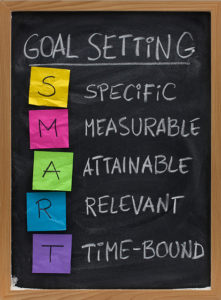Professional Goal: take risks – fail – learn
I was never a fan of SMART goals.

The idea always sounded good but actually coming up with something each fall that met the following criteria always felt very contrived to me.
Specific – does it target a specific area for improvement?
Measurable – how are you measuring your success?
Attainable – is it achievable?
Relevant – is it connected to your work?
Time-bound – when will you achieve it by?
As a result, I often resorted to selecting the massive tasks that I would like to complete to feel like I am doing my job regardless of how important they felt to me personally. These tasks were so big that even though I could make them fit the SMART goal criteria, they often changed over the course of the year and thus went “unmet” while new tasks were completed.
This year, as the date for sharing my Professional Goals was looming I was in the midst of planning a Role of Technology workshop and came across this video by Michael Wesch What Baby George Taught Me About Learning:
Watching it didn’t necessarily provide the insight about the workshop I was hoping for but it did make me reflect on my own learning. Listening to Michael Wesch’s presentation made me wonder:
How do we get students to take risks, fail and want to learn?
He thinks it might be by asking questions, making connections and taking chances – that sounds like inquiry to me!
He claimed that what university students really want to know is: Who am I? What am I going to do? Am I going to make it?
What makes finishing something worth it? What makes my job worth it?
Rather than a grade, when students receive a “not yet” and feedback – they help one another succeed. It might be that “genuine connections may restore the sense of joy and curiosity that we hope to instill in our students” How can I help instill that ethos in the groups I am a part of at school?
As a result, I considered what risks could I take to learn something new that might help me with my job and would feel like a real accomplishment if I succeed. However, I also want it to be something that as I try to learn it, I may well fail. This is what I have brainstormed so far that I would really like to invest time learning:
- How to make a “real” film
- The advantages of different programming languages that are used “in the real world” and how they work
- How to integrate makerspaces into other learning
- How to create an app relatively easily
Funny thing is, now that I am looking up information on SMART goals to write this blog post, I see that, according to Wikipedia, the different letters in the acronym have be adapted by different people to mean many slightly different things. If I think about it this way, it feels much less constrictive:
- Specific
- Motivating
- Action-oriented
- Realistic
- Trackable
And as I reflect on what I want to learn about, I can easily come up with a SMART goal but first I had to consider what I really wanted to learn!
Leave a Reply